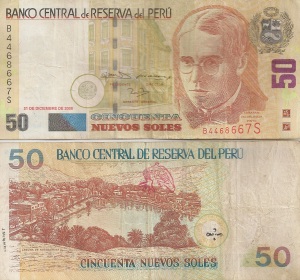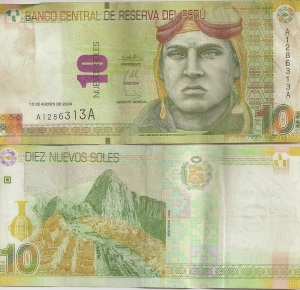Peru: Know Your Currency – Part One
Day 003 – July 25, 2011
Previous posts have talked about our adventures in the local economy. There are some stores, mainly larger grocery stores, that take the currency of the United States of America, the dollar. However, these places give your change back in the Peruvian currency, the nuevo sol, or simply sol for short.
After a few of these outings over the weekend, we had a tidy collection of soles, both paper and coin. The sol can be divided into 100 units called centimos. Peruvian coins come in the following denominations: one, five, ten, twenty, and fifty centimos.
The newness here in Peru that I find interesting is that there are sol coins also. This is akin to dollar coins in the United States, but the concept works here as opposed to the utter and dismal failure back in the States (and here and here).
The metal version of the sol comes in values of one, two, and five.
The obverse of all the coins shows the value while the reverse shows the coat of arms of Peru.
The 2 and 5 soles coin have representations of the Lines of Nazca.
(Little known fact: Thirty-six miles outside of Nazca, Peru, there are other mysterious lines carved into the desert plain. Those lines only make left-hand turns and they are called the Lines of Nascar.)
I’ll wait for you to stop groaning.
In case you were wondering why part of the title of this entry contains the text “Part One”, it’s because this post will only talk about two of the soles bills that Peru uses. This is what is known in the artistic world as “the cliffhanger” (also known as the “…to be continued” effect in the world of television).
Speaking of art (nice segue, eh?) this takes us to the subject of the subject on the fifty soles.
The bespectacled gentleman you see is Abraham Valdelomar Pinto (1888 – 1919). His Wikipedia entry describes him as…
a Peruvian narrator, poet, journalist, essayist and dramatist; he is considered the founder of the avant-garde in Peru, although more for his dandy-like public poses and his founding of the journal Colónida than for his own writing, which is lyrically posmodernista rather than aggressively experimental.
Credited with writing essays, poetry, plays, biographies, and novels, this would be like having a combination of Allen Ginsberg and Issac Asimov on the $50 note (which, truth be told, is something I would pay $50 for the U.S. Mint to do).
I found a fragment of one of Valdelomar’s poems entitled Tristita, which starts off…
Mi infancia que fue dulce, serena, triste y sola
se deslizó en la paz de una aldea lejana,
entre el manso rumor con que muere una ola
y el tañer doloroso de una vieja campana.
Since my Spanish is atrocious (see Disclaimer No. 2), I asked Google Translate for assistance and it provided the following…
My childhood was sweet, serene, sad and lonely
slipped into the peace of a remote village,
between the gentle sound that dies a wave
and the painful toll of an old bell.
The reverse of the cincuenta soles bill shows Laguna de Huacahina, an oasis in the desert near Ica, a city in southern Peru.
The 10 soles note can be seen here…
The man on the obverse is a Peruvian military aviation hero José Abelardo Quiñones Gonzáles (1914 – 1941). He is revered for his sacrifice during the 1941 war between Peru and Ecuador, when, after taking heavy damage to this plane, he crashed his aircraft into the Ecuadorian positions.
He is also credited with being the first cadet at Central Aviation College Jorge Chávez to perform an inverted loop. This explains why the older version of the ten soles bill has an upside-down plane on the reverse. At first I thought it was a misprint (similar to this famous oops), but the printers meant to do that.
The current reverse of the diez soles note shows some place or other.
As a final note on these notes, please do not print out these sample images and try to pass them off as real. Counterfeiting is sort of an issue here.
Posted on September 14, 2011, in Difference, Peru and tagged Abraham Valdelomar Pinto, centimos, currency, Jose Abelardo Quinones Gonzalez, nuevo soles, Peru, soles. Bookmark the permalink. 15 Comments.


I had heard there are one centimo coins, but I have never actually seen one. Most of the street vendors and tienda owners will not even accept the 5 centimo coins. You can only spend them at the supermercados, and even there most people seem to just stick them in the “donate to whatever” cans at the register.
The one centimo coin is much smaller than any other centimo coin. About half the size of a penny. Probably about the size of an average pinkie fingertip.
At our local grocery store, when the total is being rung up, I always donate to the charity that’s been sponsored. It seems like a drop in the ocean to me, but all of those drops add up.
Hi there! I simply want to give an enormous thumbs up for the good
info you have right here on this post. I will be coming back to your blog for more soon.
I’m really impressed with your writing skills and also with the layout on your blog. Is this a paid theme or did you modify it yourself? Anyway keep up the excellent
quality writing, it is rare to see a great blog like this one these days..
Pingback: Why Would I Cancel My Order? « Sin Polaris
Pingback: Peru: Know Your Currency – Part Two « Sin Polaris
Pingback: Paper, Not Plastic « Sin Polaris
Pingback: The Tooth Fairy Visits « Sin Polaris
Pingback: Peru: Know Your Currency – Part Three « Sin Polaris
Pingback: Error Flags « Sin Polaris
Pingback: One Raindrop Raises The Sea « Sin Polaris
Pingback: March 30, 2012: Peru 21 « Periodically, Peru
Pingback: Alternate History « Sin Polaris
Pingback: Know Your Currency: The 2012 Edition « Sin Polaris
Pingback: Photo Friday: Reflected « Sin Polaris